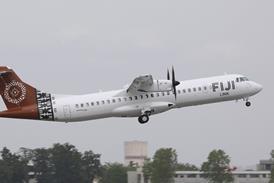Hailed as a watershed in international policy-making on climate change, the "aggressive plan" of action proposed by the International Civil Aviation Organisation group tackling aviation's greenhouse gas emissions has produced a mix of reactions. They range from a workmanlike response from European negotiators to keen disappointment from environmentalists.
Meeting for the fourth time, the Group on International Aviation and Climate Change (GIACC) recommended a global technology-led aspirational goal of 2% annual improvement in fuel efficiency of the international civil aviation in-service fleet, representing a cumulative improvement of 13% in the short term to 2012, 26% in the medium term to 2020 and about 60% in the long term to 2050, using 2005 as a base level.
 |
|---|
© Rex FeaturesIs there light at the end of the emissions tunnel? |
"This plan reflects the strong commitment of states to co-operate on specific actions and measures required to tackle the urgent issue of climate change," says Roberto Kobeh González, president of the council of ICAO.
UNDER FIRE
The plan came under fire early on for lacking ambition while it was defended by others in recognition of the fact that it simply sought first-step consensus between the 190 signatory states of ICAO while taking into account the principles of common but differentiated responsibilities and respective capabilities of developing countries under the United Nations Framework Convention on Climate Change (UNFCCC).
And that is not to mention the steps GIACC took to observe also the principles of non-discrimination and equal and fair opportunities to develop international aviation enshrined in the Convention on International Civil Aviation, the charter of ICAO.
The big sticking point with critics was the thorny issue of market-based measures such as emissions trading across national borders. This produced little more than a recommendation that ICAO undertakes "to develop, expeditiously, a framework for market-based measures in international aviation, taking into account the conclusions of an ICAO high-level meeting on the subject to be held from 7-9 October and the outcome of the Conference of the Parties (COP-15) of the UNFCCC in Copenhagen, in December".
So how ambitious is the proposed plan in reality?
Tim Johnson from the Aviation and Environment Federation (AEF), who is an observer at ICAO, says a lot more could have been achieved: "While the GIACC recommendations live up to the group's unambitious terms of reference, we are nevertheless hugely disappointed that it could not find any consensus on what we believe to be the cornerstone of any climate strategy: a base year for measurement, a target for reduction in absolute terms and the identification of global mitigation measures that many in the industry have called for to avoid a patchwork of regional measures."
He says the recommendations appear, rather, to support states taking what they independently consider to be the most appropriate action and that the aspirational fuel efficiency goals of 2% a year out to 2050 need to be put into context.
"Over the last decade or so the global fleet has improved its efficiency at or close to 2% per annum so the commitment is no more than a signal to maintain an existing trend, and while we recognise that gains get harder with time, it nevertheless fails to send a convincing message, especially when set against future traffic growth predictions. The recommendations clearly fall short of global expectation," says Johnson.
It is, however, hardly the end of international aviation's response to fight climate change at state level. As Johnson notes, GIACC merely forms the basis of the input to ICAO's high-level meeting in October, where states still have the opportunity to propose more ambitious text, an opportunity the AEF hopes they will grasp.
To be fair, GIACC members themselves agreed at the outset that their decisions should not prejudge the outcome of the negotiations under the UNFCCC and Kyoto Protocol at Copenhagen at the end of the year.
The reaction of Europe, which has arguably forced international aviation's hand with the unilateral move to wrap aviation in to its regional carbon trading scheme, proved the most intriguing, with lead negotiators viewing GIACC's diligence simply as the basis for more exacting discussions.
Daniel Calleja Crespo, director of air transport at the European Commission speaking at the recent ACI-Europe annual assembly in Manchester, said that even though Europe's go-it-alone stance had effectively forced ICAO's hand, any prospect of an international multilateral agreement would encourage the European Union to adapt its own scheme.
"Europe is also ready to recognise equivalent systems from third countries to avoid any overlapping," he said, pointing out that negotiations have already begun between Brussels and Australia and New Zealand.
"We have also been very interested in recent moves on establishing cap and trade systems in the USA," he said, referring to the proposed Waxman-Markey legislation and adding that Europe respects the autonomy of each country to establish the basis of their own system. "Some people think GIACC has been highly unambitious and has failed, but actually the Commission disagrees.
"There is now a framework with which we can work on global aspirational goals and the possibility of more ambitious goals that would allow carbon neutral growth by 2020 and a basket of measures to assist states which could include a process for developing a global framework for market-based measures," he said.
"Many suspect that COP-15 will agree nothing on international aviation, but the truth is that there are growing calls for international aviation to be added at the Copenhagen negotiations. The major challenge will be how to resolve UNFCCC principles of common but differentiated responsibilities and ICAO's non-discrimination rules."
Calleja Crespo remains coy on whether Europe's 2012 deadline for the inclusion of international aviation within its own scheme is set in stone and even hints of a question mark over hypothecation rules governing where the revenues go - currently not back into developing greener aviation technologies.
As any skilled negotiator will do, he sets the red line high, pointing out that the directive has now been passed and that while it is now simply a matter for member states to transpose into national law, the Commission could see flexibility being introduced if a willingness was expressed to develop an overarching global framework.
AMBITIOUS EUROPE
"We are going to go ahead but I would prefer to take the industry with us," he says. "Europe has always been more ambitious and by December we will know more if there is a better prospect of securing a global deal.
Even so, he talks of negotiations continuing in earnest until the nitty gritty detail is hammered out at ICAO's next triennial general assembly in 2010. Such a can-do spirit from a make-do-and-mend position from the EC leaves environmentalists unimpressed.
"In a global agreement, isn't it the consensus-based lowest common denominator stuff that actually defines the action? Still, reading between the lines, it suggests some opportunity for ICAO's high level meeting to turn it around," says Johnson.
So can ICAO deliver a more meaningful contribution that will placate those with a more ambitious vision?
GIACC - in the same way that turkeys do not vote for an early Christmas - crucially still sees ICAO as having a centralised responsibility in the whole management of international aviation's efforts to harness carbon emissions with states encouraged to develop and file individual action plans with ICAO, which will be on hand to offer co-ordination, assistance and guidance if needed on the adoption of the measures.
But even this is a moot point with some. Environmental groups, for example, have already welcomed the call by Australia effectively to strip ICAO of its responsibility for developing and implementing reduction targets, saying the UNFCCC climate talks process should take charge and set a framework and targets to be built into a new treaty by 2011.
"Australia's move follows recent scientific reports suggesting that if aviation and shipping emissions continue unchecked they could grow by 2050 to represent 50% or more of the total greenhouse gas emissions permissible worldwide to keep global warming below 2°," says Bill Hemmings of Transport & Environment. The European organisation remains suspicious of what amounts to the concerted efforts of ICAO, aviation industry lobby the International Air Transport Association, as well as several developing countries, of actively blocking progress in the aviation sector over the past 12 years.
Source: Flight International























